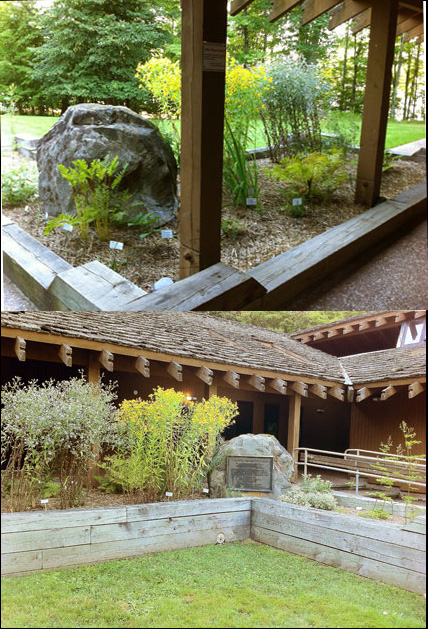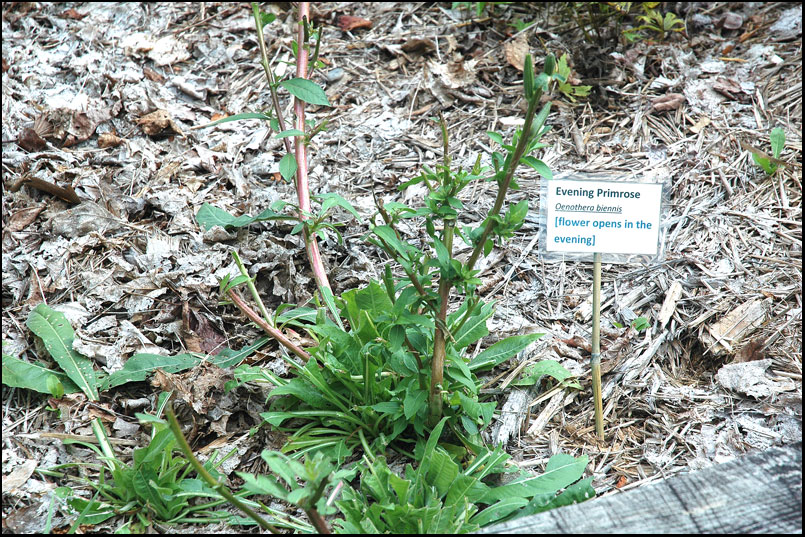Home > Activities > Projects & volunteering >
Clark Lake native plants garden
Project leader: W. Brinkmann
In September 1967, Lady Bird Johnson came to officially dedicate Sylvania to all Americans at a beach-side ceremony on the north shore of Clark Lake. A plaque mounted on a large stone commemorates her visit and the dedication. At the time of Lady Bird Johnson's visit, the stone was locate at the beach. In fact, some older pictures show the lake right behind the stone. It has since been moved and is now sitting inside a wooden L-shaped box at the day-use building. Small white (decorative) stones initially covered the soil. Many of them have since migrated downward. This opened up the soil surface to a variety of weeds. It also made digging up the weeds difficult.
One of the Friends of Sylvania's projects is to turn this box into an educational 'native plants garden'. Specifically, we are planning to have several similar-looking plants, such as a variety of ferns, so that visitors can study the small differences and will then be able to identify the plants in the wild.

Prior to
8 June 2010:
Mostly dandelions with some white rock pieces.
8 June 2010:
The Friends of Sylvania removed the weeds, added some topsoil and shredded cypress mulch, and planted the first native plants (with help from Ottawa National Forest employees, especially Jessica Majeske).
17 June 2010:
The beginning of the fern collection (interrupted and ostrich ferns), as well as a jack-in-the-pulpit and two different solomon's seals. (We had to add a short, decorative fence because kids jumped into the box and stepped on the plants.)
24 June 2010:
More plants and the beginning of signs identifying the plants. So far, there has been no need for someone to water between visits since it rained almost every other day.
1 July 2010:
Continuing to add more ferns as well as flowers, such as this bunchberry.

July & August 2010:
Continuing to add more plants, such as grasses
and these pearly everlasting
and three different goldenrods.
September-
October 2010:
asters and sneezeweed are blooming:
The end of the season.
(We will add more native plants in 2011.)

2011:
Almost all of the plants planted in 2010 came up this year.
Some animal (deer or rabbit) discovered our garden and eat some of the plants (Solomon's Seal, Jack-in-the-Pulpit, and the top of some goldenrod).
Because of the new invasive plants project, only two more plants were added (a maidenhair and a horsetail).
By the end of the summer, the sneezeweed and the asters were huge (and provided a nice shade for the ferns).

2012:
We designed a sign for the native plant garden this past winter and installed it (using the post and stand created by Cameron Coleman) at our first social gathering in May.
The sign defines native plants and explains the selections of plants in our garden.
The Forest Service installed a beautiful nesting struckture to attract mason bees to our garden.
Mason bees are small bees that provide pollinating service. They do not sting and they do not live in hives like honey bees. Instead, they use holes in wood, such as tunnels made by woodpeckers. The females lay eggs in the tunnel and then plug the opening with mud.
The nesting structure the Forest Service installed is made of bamboo tubes.

Last year, something was eating the Solomon Seal plants; this year, something is eating the Evening Primrose plant (leaves, stems, and buds)!
2013: We began developing plans for some interesting additions, such as a moss-covered log.
2014:
Work on the Day-use building started in the fall of 2013 and will continue through 2014. To protect the garden, it was covered with plastic during the winter and during the summer of 2014 had a red tape running around it.
This means that we will not be able to doing anything in 2014.
PS: The red area in the upper right corner is the photographer's finger on the iPhone lense.
Photos by W. Brinkmann

